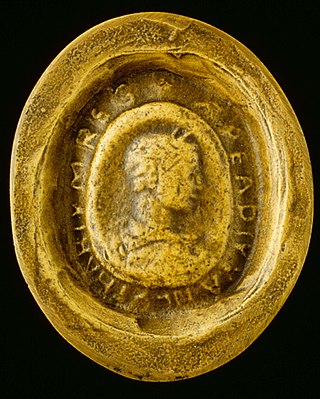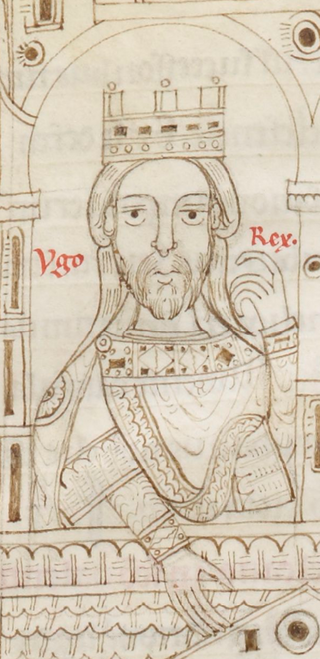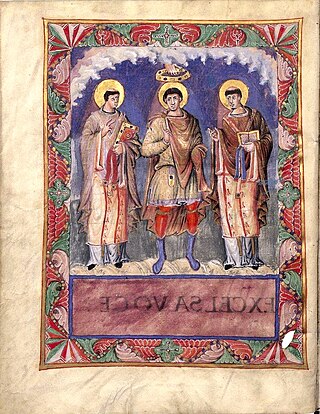Related Research Articles
Pope Nicholas I, called Nicholas the Great, was the bishop of Rome and ruler of the Papal States from 24 April 858 until his death. He is remembered as a consolidator of papal authority, exerting decisive influence on the historical development of the papacy and its position among the Christian nations of Western Europe. Nicholas I asserted that the pope should have suzerainty over all Christians, even royalty, in matters of faith and morals.

Lothair I or Lothar I was emperor, and the governor of Bavaria (815–817), King of Italy (818–855) and Middle Francia (840–855).

Lothair II was the king of Lotharingia from 855 until his death. He was the second son of Emperor Lothair I and Ermengarde of Tours. He was married to Teutberga, daughter of Boso the Elder.

Louis II, sometimes called the Younger, was the king of Italy and emperor of the Carolingian Empire from 844, co-ruling with his father Lothair I until 855, after which he ruled alone.

Hugh, known as Hugh of Arles or Hugh of Provence, was the king of Italy from 926 until his death. He belonged to the Bosonid family. During his reign, he empowered his relatives at the expense of the aristocracy and tried to establish a relationship with the Byzantine Empire. He had success in defending the realm from external enemies, but his domestic habits and policies created many internal foes and he was removed from power before his death.
Teutberga was a queen of Lotharingia by marriage to Lothair II. She was a daughter of Bosonid Boso the Elder and sister of Hucbert, the lay-abbot of St. Maurice's Abbey.

The Kingdom of Upper Burgundy was a Frankish dominion established in 888 by the Welf king Rudolph I of Burgundy on the territory of former Middle Francia. It grew out of the Carolingian margraviate of Transjurane Burgundy southeast of ('beyond') the Jura Mountains together with the adjacent County of Burgundy (Franche-Comté) in the northwest. The adjective 'upper' refers to its location further up the Rhône river, as distinct from Lower Burgundy and also from the Duchy of Burgundy west of the Saône river. Upper Burgundy was reunited with the Kingdom of Lower Burgundy in 933 to form the Kingdom of Burgundy, later known as Kingdom of Arles or Arelat.
Adalbert II, called the Rich, son of Adalbert I, Margrave of Tuscany and Rothild of Spoleto. He was a grandson of Boniface II, and was concerned with the troubles of Lombardy, at a time when so many princes were contending for the wreckage of the Carolingian Empire. Before his father died in 884 or 886, he is accredited the title of "count". He inherited from his father the titles of Count and Duke of Lucca and Margrave of Tuscany.
Boso was a Burgundian nobleman who spent much of his career in Italy, where he became Margrave of Tuscany about 932. He ruled semi-autonomously and was a benefactor of the churches of his region. He lost his office in 936 and probably returned to Burgundy.
Gunther or Gunthar was Archbishop of Cologne in Germany from 850 until he was excommunicated and deposed in 863.
Ermengard of Italy, also Ermengarda, Ermengarde, or Irmingard was a queen and regent of Provence. She was the second and only surviving daughter of Louis II, Holy Roman Emperor.
Engelberga was the wife of Emperor Louis II and thus Carolingian empress to his death on 12 August 875. As empress, she exerted a powerful influence over her husband.
Hugh or Hugo was an illegitimate son of Lothair II, king of Lotharingia, by his concubine Waldrada. His father made him Duke of Alsace in 867.
Bertha was countess of Arles by marriage to Theobald of Arles, and margravine of Tuscany by marriage to Adalbert II of Tuscany. She served as regent of Lucca and Tuscany from 915 until 916 during the minority of her son Guy of Tuscany. She was described as beautiful, spirited and courageous, while her influence over her spouse was, coupled with ambition, attributed to have involved her husbands in many wars.
The Bosonids were a dynasty of Carolingian era dukes, counts, bishops and knights descended from Boso the Elder. Eventually they married into the Carolingian dynasty and produced kings and an emperor of the Frankish Empire.
Theotgaud was the archbishop of Trier from 850 until his deposition in 867. He was the abbot of Mettlach prior to his election in 847 to succeed his uncle, Hetto, as archbishop.
Hucbert was a Frank and son of the count Boso the Elder. Therefore, he was a Bosonid, and the namesake for the Huberterian branch of the family. His rise to power commenced under Lothair I but continued under Lothair II, reaching its apex when his sister Theutberga married Lothair II, a prince of the Carolingian dynasty, the imperial family of Francia. Hucbert also served as the lay-abbot of the Abbey of Saint Maurice-in-Valais. This gave him control over the Mons Iovis pass, the main route between Francia and Italy. Hucbert later gained power in the region of Transjurane Burgundy (859) which is what helped him later to find safety within the kingdom of Charles the Bald.
The De divortio Lotharii regis et Theutbergae reginae is an extended mid ninth-century treatise written by Hincmar, Archbishop of Reims, which survives in a single manuscript, Paris BnF. lat. 2866. The front few pages of this manuscript have been lost, and so this is an assumed title. It explores the issues arising from the attempt by Lothar II, king of Lotharingia (855–869), to rid himself of his wife Teutberga and replace her with his concubine, Waldrada. Hincmar is primarily concerned with defining what marriage is and how it may be ended, and with the duties of bishops and of kings. However, in the course of discussing these questions, he touches on many other issues too, and gives much detail on ninth-century politics and religious practice in Francia.

Adventius was the Bishop of Metz from 855 until his death in 875. He was a prominent figure within the courts of the Carolingian kings Lothar II (855–869) and Charles the Bald (840–877).
The Council of Metz of 863 was arranged by Pope Nicholas I to discuss the divorce case of Lothar II, king of Lotharingia, and his wife Theutberga. The council was mainly attended by Lothar II's supporters, and thus concluded the divorce case in his favour; this decision was later overruled by Pope Nicholas I who suspected foul play. It was the fourth and final council called during the reign of Lothar II. No documents from the council survive, but as the council was controversial it is discussed in other medieval sources such as the letters of Pope Nicholas I, the Annals of St Bertin, the Annals of Fulda and the Liber Pontificalis.
References
- 1 2 (in French) Baron Ernouf (1858) Histoire de Waldrade, de Lother II et de leurs descendants, p. 3
- ↑ (in French) Baron Ernouf (1858) Histoire de Waldrade, de Lother II et de leurs descendants, p. 5
- ↑ K. Schmid, Ein karolingischer Königseintrag im Gedenkbuch von Remiremont, Frühmittelalterliche Studien, 2, 1968, pp. 96-134
- ↑ Monumenta Germanica Historica, tomus XV.2, Vita Sancti Deicoli, p. 679.
- ↑ Monumenta Germanica Historica, tomus I: Annales Lobienses, anno 855, p. 232
- ↑ Wickham, Chris (1990). Early Medieval Italy: Central Power and Local Society 400-1000. University of Michigan Press. pp. 59–60. ISBN 0-472-08099-7.
- ↑ Townsend, Geo (1847) Ecclesiastical and Civil History Philosophically Considered, Vol. II, p. 157